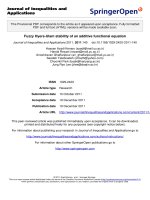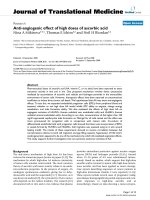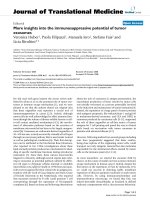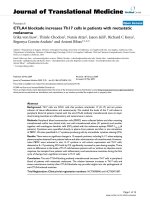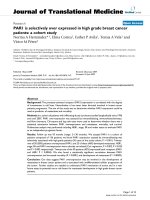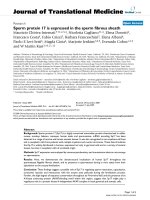Báo cáo hóa học: " Ultrafast hole carrier relaxation dynamics in p-type CuO nanowires" ppt
Bạn đang xem bản rút gọn của tài liệu. Xem và tải ngay bản đầy đủ của tài liệu tại đây (1.46 MB, 5 trang )
NANO EXPRESS Open Access
Ultrafast hole carrier relaxation dynamics in
p-type CuO nanowires
Andreas Othonos
1*
and Matthew Zervos
2
Abstract
Ultrafast hole carrier relaxation dynamics in CuO nanowires have been investigated using transient absorption
spectroscopy. Following femtosecond pulse excitation in a non-collinear pump-probe configuration, a combination
of non-degenerate transmission and reflection measurements reveal initial ultrafast state filling dynamics
independent of the probing photon energy. This behavior is attributed to the occupation of states by photo-
generated carriers in the intrinsic hole region of the p-type CuO nanowires located near the top of the valence
band. Intensity measurements indicate an upper fluence threshold of 40 μJ/cm
2
where carrier relaxation is mainly
governed by the hole dynamics. The fast relaxation of the photo-generated carriers was determined to follow a
double exponential decay with time constants of 0.4 ps and 2.1 ps. Furthermore, time-correlated single photon
counting measurements provide evidence of three exponential relaxation channels on the nanosecond timescale.
Keywords: CuO nanowires, pump-probe spectroscopy, carrier dynamics
Introduction
Low-dimensional semiconductor nanostructures have
been an active field of research due to their fascinating
physical properties which are very different from their
bulk counterparts. An important class of such nanostruc-
tures are semiconducto r nanowires [NWs] since they
may be used as building blocks for electro nic and photo-
nic devices which have attracted a great deal of attention
over the past few years [1-3 ]. So far, a broad variety of
metal-oxide [MO] N Ws such as ZnO, SnO
2
,In
2
O
3
,and
Ga
2
O
3
have been grown and investigated in view of their
potential technological applications. However, most of
theseMONWsaren-typeduetodonorslikeoxygen-
related defect st ates t hat reside energet ically close to the
conduction band edge. Moreover, p-type doping is not
straightforward which limits the formation of p-n junc-
tions and the realization of nanoscale electronic and
optoelectronic devices. In contrast, cupric oxide [CuO] is
a p-type semiconductor with a narrow bandgap energy
(E
G
) reported to be between 1.3 and 1.7 eV [4]. The
p-type conductivity is attributed to the presen ce of nega-
tively charged copper vacancies and interstitial oxyge n
[5]. As such, CuO is regarded as an important material
for applications in photovoltaic cells because of its high
absorption coefficient, non-toxicity, and low cost.
Furthermore, CuO has been exploited as a heteroge-
neous catalyst to convert hydrocarbons into car bon diox-
ide and water [6]. However, while the growth of CuO
NWs has been investigated and understood in some
detail [7-9], it appears that very little work has been car-
ried out on their optical properties while nothing is
known about the ultrafast carrier dynamics despite their
potential to be used as building blocks in optoelectronic
devices.
In this work, CuO NWs were grown on Cu via a self-
catalyzed vapor-solid mechanism using dry oxidation and
subsequently transferred onto quartz and Si(001) sub-
strates for femtosecond transient absorption spectro-
scopy measurement s, pr oviding a detailed understanding
of the ultrafast carrier relaxation dynamics in thi s p-type
semiconductor NWs. We fin d a fast negative change in
absorption due to the occupation of states by the photo-
generatedcarriersmainlyintheintrinsicholeregion
near the top of the valence band and a recovery within a
few picoseconds associated with redistribution of the
photo-generated carriers in nearby energy states. Inten-
sity measurements reveal an upper fluence threshold of
40 μJ/cm
2
where carrier relaxation is mainly governed by
* Correspondence:
1
Research Center of Ultrafast Science, Department of Physics, University of
Cyprus, PO Box 20537, Nicosia, 1678, Cyprus
Full list of author information is available at the end of the article
Othonos and Zervos Nanoscale Research Letters 2011, 6:622
/>© 2011 Othonos and Zervos; licensee Springer. This is an Open Acce ss article distributed under the terms of the Creative Commons
Attribu tion License ( which permits unrestricted us e, distr ibution, and reproduct ion in
any medium, provided the original work is properly cited.
the hole dynamics. Furthermore, time-correlated single
photon counting [TCSPC] photoluminescence [PL] mea-
surements provide evidence of a three exponential
relaxation dynamics on the nanosecond timescale.
Experimental method
CuO NWs were grown using an atmospheric pressure
chemical vapor deposition reactor which consists of four
mass flow controllers and a horizontal quartz tube [QT]
furnace capable of reaching a maximum temperature of
1,100°C. For the growth of the CuO NWs, we used
high-purity Cu sheets with a thickness of ≈0.12 mm in
the form of strips having a width of ≈3mmandlength
of ≈10 mm. The Cu strips were flat and straight, were
cleaned sequentially in methanol, acetone, and isopropa-
nol [IPA] under ultrasonic vibration, and then rinsed in
deionized [DI] H
2
O; after which, they were dipped in
diluted hydrochloric acid at room temperature [RT] for
20 s in order to remove any oxides. Finally, the foil w as
rinsed thoroughly with DI H
2
O and dried with N
2
. Sev-
era l strips were loaded into a porcelain-type boat whic h
was positione d directly above the thermocouple used to
measure the heate r temperature at the center of the 1";
QT. The latter was flushed using an Ar-to-O
2
ratio of
500:100 sccm for 10 min, and then the temperature was
ramped to the growth temperature [T
G
]usingaslow
ramp rate of 5°C/min and 100 sccm of O
2
. Upon reach-
ing T
G
, the same flow of 100 sccm O
2
was maintained
for a further 1 to 4 h. The furnace was th en allowed to
cool down to RT using the same flow of O
2
.TheCu
foils turned black and were removed from the 1"; QT
only when the temperature was < 100°C in order to pre-
vent cracking due to stress. The morphology of the
CuO NWs were then examined with a TESCAN scan-
ning electron microscope [SEM] (TESCAN USA, Cran-
berry Twp., PA, USA) while their crystal structure and
phasepuritywereinvestigatedusingaSHIMADZU,
XRD-6000, X-ray diffractometer (Shimadzu Corporation,
Nakagyo-ku, Kyoto, Japan) with a Cu-Ka source, by
performing a scan of θ-2θ in the range between 10° and
80°.
The dynamic behavior of carriers within the CuO NWs
was investigated by measuring the temporal behavior of
ultrafast time-resolved absorption obtained from simulta-
neous measurements of time-resolved transmission and
reflection [10-12]. The experiments were carried out using
a Ti/sapphire ultrafast amplifier system generating 100-fs
pulses at 800 nm and running at a repetition rate of
1 kHz. A nonlinear crystal was used to generate 400 nm
for the purpose of exciting the NWs, whereas part of the
fundamental was used to generate a super continuum
light for probing different energy states. Measurements
were carried out using a typical pump-probe optical setup
in a non-collinear configuration where differential
reflection and transmission were utilized to determine the
transient absorption.
Results and discussion
A high yield uniform distribution of CuO NWs with a
characteristic black appearance was obtained on the thin
Cu foil. A typical SEM image of the CuO NWs that
were grown at 600°C for 1 h is shown as an inset in
Figure 1. The CuO NWs are straight and have diameters
≤ 200 nm and le ngths of up to 10 μm. These exhibited
clear peaks in the XRD corresponding to the monoclinic
crystal structure of CuO, while additional peaks were
also observed due to the underlying red-like Cu
2
Oand
Cu foils. The CuO NWs grow in a self-catalyzed fashion
via the formation of a strained layer of Cu
2
O on Cu and
the subsequent diffusion of Cu and O
2
through grain
boundaries.
As-grown samples were carefully immersed into a vial
containing a few milliliters of IPA under ultrasonic
vibration for short time intervals between 1 and 10 s in
order to harvest CuO NWs and transfer them onto Si
(001) or quartz for the purpose of optical spectroscopy.
The light gray solution obtained after sonication was
applied drop by drop on Si(001) and quartz, allowing
the solvent to evaporate in between. A typical distribu-
tion of CuO NWs obtained in this way on Si(001) is
shown as an inset in Figure 2.
Ultrafast, time-resolved, differential absorption mea-
surements for the CuO NWs using different p robing
wavelengths are shown in Figure 2. The femtosecond
excitation pulse was set at 3.1 eV with the a bsorbed flu-
ence esti mated to be 210 μJ/cm
2
. At first sight, the beha-
vior appears to be similar for all probing wavelengths;
that is, there seems t o be a fast decre ase (pulse width
Figure 1 XRD spectrum of the CuO NWs .TheCuONWswere
grown at 600°C for 4 h under 100 sccm of O
2
identified by the
(110), (002), (111), and (113) peaks. The inset shows an SEM image
of the as-grown CuO NWs.
Othonos and Zervos Nanoscale Research Letters 2011, 6:622
/>Page 2 of 5
limited) in optical absorption reaching a minimum, fol-
lowed by a fast recovery toward a plateau within 5 to 10
ps, and then returning back to its equilibrium value over
several nanoseconds.
The observed transient absorption changes in a semi-
conductor follo wing the a bove bandgap femtosecond
pulse excitation are associated with the generation of non-
equilibrium carrier densi ty via the excitation of electrons
from the valence to the conduction band (seen in Figure 3
as process A). However, in a p-type semiconductor like
CuO, in addition to the normal excitation of electrons
from the valence to the conduction band, the excitation of
electrons within the valence band states, from the states
below the Fermi energy to the available empty hole states
(seen in Figure 3 as process B) near the top of the valence
band [4], has an important contributing factor to the tran-
sient absorption changes. As the system evolves toward
equilibrium, the photo-generated carriers distribute them-
selves along the energy states that are normally unoccu-
pied under equilibrium conditions. In our measurements,
this appears as a negative c hange in the induced ab sorp-
tion and is observed for all the probing photon energies
(above and below the bandgap energy) with similar initial
recovery. In view of this, along with the fact that we are
probing a p-type semiconductor with a large intrinsic hole
density [13], we believe that the observed initial drop in
absorption is mainly associated with the occupation of
states in the valence bands/sub-bands while its recovery
corresponds to photo-generated carriers moving out of
the probing region. On the other hand, the observed long-
lived negativ e signal fo r probing energies larger than 1.5
eV corresponds to the contributions from additional state
filling at different energy states, possibly due to the occu-
pation of defect states[DS]/surface states (DS is seen in
Figure 3), conduction band, or lower valence band states.
A competing process known as ‘free-carrier absorption’
is also likely to occur due to secondary excitation of the
photo-generated carriers by the probing photons from
their initial states to higher energy states. This phenom-
enon will result in a positive change in the induced
absorption and is observed for probing wavelengths lar-
ger than 830 nm as seen in Figure 2, where carriers
undergo secondary excitation. We should point out that
the temporal behavior of the recovery which is on a
nanosecond timescale is the same as the one observed for
the long-lived state filling, suggesting that we are probing
the same states. The observed long-lived behavior in
comparison with the fast recovery of the initial state fill-
ing signifies the difference of the probing states. This
suggests that for the long-lived behavior, we are probably
probing defects/surface states rather than valence or con-
duction band states.
Intensity measurements shown in Figure 4 reveal a lin-
ear increase in the peak of the induced absorption with
the incident fluence reaching saturation at the 390 μJ/cm
2
.
Here, we should point out that there is a slight decrease in
the recovery with the increasing fluence. Similar results
have been obtaine d for the ot her probing w avelengths.
Intensity measurements also reveal that at fluence lower
than 40 μJ/cm
2
, there is a negligible long-lived state filling
contribution; therefore, the dynamics depict the temporal
behavior of the top valence band holes. The best fit to
these data was obtained with a double exp onential func-
tion with time constants (associated strengths) of 0.4 ps
Figure 2 CuO NWs’ time-resolved differential absorption with
3.1-eV (≡400 nm) excitation and different wavelength probing.
The estimated absorbed fluence was 210 μJ/cm
2
. The lower inset
shows the SEM image of the transferred wires.
Figure 3 A simplified schematic of the CuO band structure.Itis
with an intrinsic hole population at the top of the valence band.
Generation of non-equilibrium carrier densities via processes A and
B are also shown in the diagram.
Othonos and Zervos Nanoscale Research Letters 2011, 6:622
/>Page 3 of 5
(67%), associated with a redistribution of the photo-gener-
ated carrier in nearby energy states, and 2.1 ps (33%) cor-
responding to the carrier relaxation to further energy
states from the probing region.
To obtain a better understanding of the dynamics in
the CuO NWs on a longer time scale, time-resol ved
room temperature PL was carried out using TCSPC. The
excitation was provided using a Ti/sapphire ultrafast
amplifier, generating 267 nm at a repetition rate of 250
kHz. The spot size of the focused b eam was approxi-
mately 2 mm. A further reduction of the incident inten-
sity using a neutral d ensity filter in front of the laser
source revealed that the time constants were independent
of the inciden t int ensity. Figure 5 shows the TCSPC data
obtained at several emission wavelengths namely at l =
350, 400, and 500 nm covering the peak spectra region of
the broad PL emission from the CuO NWs, as shown in
the inset at the upper corner [14]. The same RT PL was
obtaineddirectlyfromtheas-grownCuONWs.We
should point out that the PL emission from CuO as
demonstrated from a previous work has drastically differ-
ent profiles, depending on the sample preparation condi-
tions. Given the narrow bandgap of CuO and the
intrinsic hole concentration of this p-type semiconductor
system, the PL emission following photoexcitation is
most likely associated with the recombination of elec-
tronsfromthetoptothelowervalencebandstatesas
well as the contribution from surface or defects states
within the gap (Figure 3).
The decay profiles of the TCSPC measurements are
approximately the same f or the different probing w ave-
lengths. The deca ys are well described by an exponential
function of the form I(t) =A
1
e
-t/τ
1
+A
2
e
-t/τ
2
+A
3
exp
-t/τ
3
,
suggesting a complex energy level structure for the CuO
NWs. The average expone ntial time constants and their
associated strengths for the three probing wavelengths
are 1.0 ns (80%), 4.8 ns (18%), and 26 ns (2%). This
multi-exponential decay of the PL signal indicates th e
existence of non-radiative channels available to the prob-
ing carriers. Although the measured PL signal comes
from a partic ular energy state, the non-radiative channels
available to the photo-gene rated carriers in these states
alter the population, thus making the PL decay appear
multi-exponential.
Conclusions
In conclusion, C uO NWs have been grown by dry oxi-
dation of high-purity Cu foils at 600°C which were
harvested and transferred on quartz and Si(001) sub-
strates. Ultrafast transient absorption measurements
reveal an initial pulse width-limited negati ve change in
the induced absorption for all probing wavelengths
associated with the occupation of photo-generated car-
riers of intrinsic hole states in the valence band of the
p-type CuO NWs. The recovery of the initial state fill-
ing for the low incident fluence (< 40 μJ/cm
2
)suggests
two relaxation mechanisms: a fast relaxation of 0.4 ps
(67%) associated with redistribution of the photo-gen-
erated carriers around the probing region and a slower
relaxation mechanism of 2.1 ps (33%) corresponding to
a decay channel coupled to states further from the
probing region. On a longer time scale, the TCSPC
measurements show decay profiles which are approxi-
mately the same for the probing wavelengths between
350and500nm.Thedatashowmulti-exponential
decay with time constants at 1.0 ns (80%), 4.8 ns
(18%), and 26 ns (2%).
Figure 4 CuO NWs’ intensity time-resolved differential
absorption with 3.1-eV excitation (400 nm) and 770-nm
probing.
Figure 5 CuO NWs’ TCSPC PL excited with 267-nm ultrafast
pulses and probe at 350, 400, 500 nm. The inset shows a steady
state PL spectrum from CuO NWs that were transferred on Si(001).
Othonos and Zervos Nanoscale Research Letters 2011, 6:622
/>Page 4 of 5
Abbreviations
IPA: isopropanol; MO: metal oxide; NWs: nanowires; PL: photoluminescence;
SEM: scanning electron microscope; TCSPC: time-correlated single photon
counting.
Acknowledgements
The work in this article was partially supported by the research programs,
ERYAN/0506/04 and ERYAN/0508/02, funded by the Cyprus Research
Promotion Foundation in Cyprus.
Author details
1
Research Center of Ultrafast Science, Department of Physics, University of
Cyprus, PO Box 20537, Nicosia, 1678, Cyprus
2
Nanostructured Materials and
Devices Laboratory, Department of Mechanical Engineering, Materials
Science Group, School of Engineering, University of Cyprus, PO Box 20537,
Nicosia, 1678, Cyprus
Authors’ contributions
The authors contributed equally, read, and approved the final manuscript.
Competing interests
The authors declare that they have no competing interests.
Received: 10 September 2011 Accepted: 7 December 2011
Published: 7 December 2011
References
1. Lu W, Lieber CM: Semiconductor nanowires. J Phys D: Appl Phys 2006, 39:
R387-R406.
2. Bachtold A, Hadley P, Nakanishi T, Dekker C: Logic circuits with carbon
nanotube transistors. Science 2001, 294:1317-1320.
3. Huang Y, Duan XF, Cui Y, Lauhon LJ, Kim KH, Lieber CM: Logic gates and
computation from assembled nanowire building blocks. Science 2001,
294:1313-1317.
4. Ching WY, Xu Y-N, Wong KW: Ground-state and optical properties of
Cu
2
O and CuO crystals. Phys Rev B 1989, 40:7684-7695.
5. Musa AO, Akomolafe T, Carter MJ: Production of cuprous oxide, a solar
cell material, by thermal oxidation and a study of its physical and
electrical properties. Sol Energy Mater Solar Cells 1998, 51:305-316.
6. Reitz JB, Solomon EI: Propylene oxidation on copper oxide surfaces:
electronic and geometric contributions to reactivity and selectivity. JAm
Chem Soc 1998, 120:11467-11478.
7. Kaur M, Muthe KP, Despande SK, Choudhury S, Singh JB, Verma N,
Gupta SK, Yakhmi JV: Growth and branching of CuO nanowires by
thermal oxidation of copper. J Crystal Growth 2006, 289:670-675.
8. Jin C, Kim H, Hong C, Kim HW, Lee C: Preparation and
photoluminescence properties of silica-coated CuO nanowires. App Phys
A 2010, 100:151-157.
9. Huang C-Y, Chatterjee A, Liu SB, Wu SY, Cheng C-L: Photoluminescence
properties of a single tapered CuO nanowire. Appl Surf Sci 2010,
256:3688-3692.
10. Othonos A, Zervos M: Carrier relaxation dynamics in Sn
x
N
y
nanowires
grown by chemical vapor deposition. J Appl Phys 2009, 106:114303.
11. Othonos A, Zervos M, Christofides C: Carrier dynamics in β-Ga
2
O
3
nanowires. JAppl Phys 2010, 108:124302.
12. Othonos A: Probing ultrafast carrier and phonon dynamics in
semiconductors. J Appl Phys 1998, 83:1789-1830.
13. Li D, Hu J, Wu R, Lu JG: Conductometric chemical sensor based on
individual CuO nanowires. Nanotechnology 2010, 21:485502.
14. Chang S-S, Lee H-J, Park HJ: Photoluminescence properties of spark-
processed CuO. Ceramics Int 2005, 31:411415.
doi:10.1186/1556-276X-6-622
Cite this article as: Othonos and Zervos: Ultrafast hole carrier relaxation
dynamics in p-type CuO nanowires. Nanoscale Research Letters 2011
6:622.
Submit your manuscript to a
journal and benefi t from:
7 Convenient online submission
7 Rigorous peer review
7 Immediate publication on acceptance
7 Open access: articles freely available online
7 High visibility within the fi eld
7 Retaining the copyright to your article
Submit your next manuscript at 7 springeropen.com
Othonos and Zervos Nanoscale Research Letters 2011, 6:622
/>Page 5 of 5
